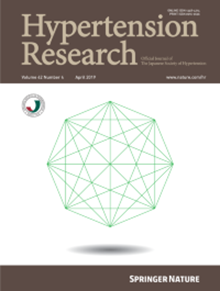在日本普通人群中,纤维化-4指数与高血压的未来发展密切相关。
IF 4.3
2区 医学
Q1 PERIPHERAL VASCULAR DISEASE
引用次数: 0
摘要
纤维化-4指数是一种评估肝纤维化的无创方法,与心血管事件密切相关。在这项研究中,我们检验了一般人群中纤维化-4指数与新发高血压相关的假设。共筛查参加健康体检的15502人(51.0±13.2岁)。排除高血压患者,对其余8719名血压正常的患者(48.4±12.6岁)进行随访(中位1739天),随访终点为新发高血压。在随访期间,1750名参与者(每1000人年39.0人)出现高血压。在Kaplan-Meier分析中,参与者根据基线时的纤维化-4指数(低,本文章由计算机程序翻译,如有差异,请以英文原文为准。

Fibrosis-4 index is closely associated with future development of hypertension in the Japanese general population
The fibrosis-4 index, a noninvasive method for evaluating liver fibrosis, is closely associated with cardiovascular events. In this study, we tested the hypothesis that the fibrosis-4 index is associated with new-onset hypertension in the general population. A total of 15,502 individuals (51.0 ± 13.2 years) who participated in our health checkup program were screened. Participants with hypertension were excluded, and the remaining 8719 normotensive participants (48.4 ± 12.6 years) were followed up (median 1739 days) with the endpoint of the new onset of hypertension. During follow-up, 1750 participants (39.0 per 1000 person-years) developed hypertension. In Kaplan–Meier analysis, where participants were divided into three groups according to the fibrosis-4 index at baseline (low, <1.30; intermediate, 1.30–2.67; high, ≥2.67), the risk of hypertension increased with increasing fibrosis-4 index (low, 33.8; intermediate, 55.2; high, 69.4 per 1000 person-years). Multivariate Cox hazard regression analysis revealed that the log-transformed fibrosis-4 index was independently associated with the development of new hypertension (hazard ratio 4.279, 95% confidence interval 3.318–5.518). These results suggest that the fibrosis-4 index is a useful tool to evaluate a risk of developing hypertension in the general population. Hypertension and liver fibrosis may share a common basis.
求助全文
通过发布文献求助,成功后即可免费获取论文全文。
去求助
来源期刊

Hypertension Research
医学-外周血管病
CiteScore
7.40
自引率
16.70%
发文量
249
审稿时长
3-8 weeks
期刊介绍:
Hypertension Research is the official publication of the Japanese Society of Hypertension. The journal publishes papers reporting original clinical and experimental research that contribute to the advancement of knowledge in the field of hypertension and related cardiovascular diseases. The journal publishes Review Articles, Articles, Correspondence and Comments.
 求助内容:
求助内容: 应助结果提醒方式:
应助结果提醒方式:


